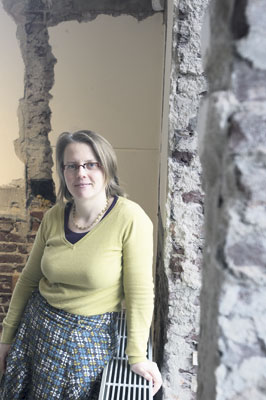Conservation specialists increasingly encounter this material, which has been used for building in the Netherlands for around 130 years. Unfortunately, conservationists lack specific knowledge about the history and properties of historic concrete; moreover, modern concrete repair techniques were never developed for conservation purposes.
In order to assess the values of cultural heritage, the material itself should also be evaluated; that is, historical studies of concrete buildings dating from the late 19th and 20th centuries should not only be presented from an architectural point of view.
The central question in my thesis is: ‘How can we obtain a transition from concrete repair to concrete conservation?’
One concrete construction I find astonishing is the Hofplein in Rotterdam, a nearly 2 kilometre-long railway viaduct just north of Rotterdam Central Station that was built between 1904 and 1908. That construction is a complete archive of concrete technology. The contractors were still learning how to make reinforced concrete as they built. No guidelines had yet been developed for them to follow.
During the interwar years (1918-1939), architects began using concrete for aesthetic purposes. One such architect was H.G.J. Schelling, whose remarkable use of exposed concrete is described in my thesis. Schelling designed a series of post-WWII railway stations in which he combined prefabricated concrete elements with various carefully selected aggregates, which he then applied in strict geometrical patterns. Take the station at Enschede for example: there, as aggregates, Schelling used crushed ceramic pipes, a mixture of crushed red and yellow fired clay bricks and bluish ceramic roof tiles, white gravel from Brunssum (Limburg province), Rhine gravel with differently coloured grain size fractions, and coloured pigments. As you see, concrete literally has a colourful history!
TU Delft is one of the cradles for concrete research in the Netherlands. Consequently, the central library contains a priceless collection of historic books about this material. Unfortunately though all the books I had borrowed in the spring of 2008 were lost in the fire that destroyed the architecture faculty building. My PhD research, which is partially a literature study, was also delayed by one year due to the fire, and I lost many samples as well, such as, for instance, a piece of material from the Defense Line of Amsterdam that was more than 100 years old. I can’t just go back there and drill a hole to get a new sample, as that construction is a Unesco World Heritage site.”
“Sinds mijn vijftiende ben ik zeilinstructeur. Ik begon destijds als stagiair en liep met een ervaren instructeur mee. Na drie zomers had ik zelf de juiste papieren. Nu geef ik les aan een groep van zes kinderen tussen de acht en veertien jaar. Zij zeilen in een Optimist, een kleine badkuip. Het ultieme beginnersbootje. Voordat we het water op gaan, geef ik uitleg wat we gaan doen en welke route gevolgd wordt. Met boeien heb ik die vooraf uitgezet. Over het algemeen zijn de kinderen ontzettend enthousiast en niet bang. Onderweg geef ik vanuit de motorboot aanwijzingen en vertel ik welke kant we op zeilen. Ik probeer de groep sowieso goed bij elkaar te houden.”
“De eerste keer dat een kind met zijn boot omslaat, schrik je je rot. Door de ervaring die je opbouwt neemt die angst gelukkig af. We oefenen er zelfs op, in veilige omstandigheden. Stel dat het tijdens een les gebeurt, dan stuur ik eerst die andere vijf naar een veilig punt, vaak een boei, waarbij ze langere tijd één koers kunnen varen. Tegelijk vaar ik naar het kind toe. In principe ga ik niet zelf het water in, dat zou me alleen maar kwetsbaar maken. Als het even kan, laat ik ‘m zelf weer in de boot klimmen. Later moeten ze het namelijk óók zelf kunnen. Wel help ik met water uit de boot scheppen en probeer ik de eerste schrik weg te nemen. Aan de kant bespreken we het met elkaar.”
“Op dit moment ben ik nog even werkloos. Het seizoen loopt namelijk van april tot en met september. Buiten de zomermaanden zijn er wel kinderfeestjes in de weekenden. Vlotten bouwen en soms een zeillesje. De cursusweken zijn in de vakantieperiode. Dan maak je dagen van half negen tot half zes. Dat betekent voorbereiden, kijken naar de weersvoorspelling. Maar ook opruimen en napraten met collega’s. Ik moet zeggen, je bent doodmoe aan het eind van zo’n dag. Vervelen doet het zeker nog niet. Je bent buiten en met mensen bezig. Daarbij is de sfeer ontzettend goed. Voorlopig heb ik dus geen behoefte aan een ander baantje.”
Bijbaan: Watersportinstructeur
Verdiensten: €8 per uur
Opvallend: Komt in vrije tijd minder aan zeilen toe



Comments are closed.